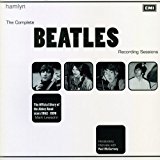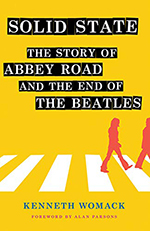- Album Songs recorded during this session officially appear on the Abbey Road LP.
- Studio:
- EMI Studios, Studio Two, Abbey Road
- Studio:
- EMI Studios, Studio Three, Abbey Road
Timeline
More from year 1969
Some songs from this session appear on:
Spread the love! If you like what you are seeing, share it on social networks and let others know about The Paul McCartney Project.
About
At this point in time, all the songs intended to be part of the long medley (named “The Long One” or “Huge Melody” at this stage) had been recorded. The goal of this day was to prepare a trial run at piecing together all those songs into one cohesive unit. But before doing this first assembly, most songs would receive overdubs. This was obviously a very long session, lasting from 2 pm to 3:30 am.
From 2 pm to 3:30 pm, six attempts at making a tape reduction of the first song of the medley, “You Never Give Me Your Money“, were done, numbered 37 to 42. Take 40 was considered to be the best and received some overdubs later that day.
Once this was done, they moved from Studio Two to Studio Three for the rest of the day.
“Come Together” was not designed to be part of the medley, but still received its final overdubs on this day, in the form of some lead guitar passages played by George Harrison.
“Polythene Pam / She Came In Through The Bathroom Window” were next to receive overdubs. Paul McCartney, John Lennon and George added backing vocals; George some guitar; and Ringo Starr some congas.
Switching to “You Never Give Me Your Money“, Paul, John and George added backing vocals in various parts of the song, including the “one, two, three, four, five, six, seven…” harmonies during its conclusion, while Ringo played the tambourine at the end of each vocal phrase.
The last ones to receive overdubs on this day were “Golden Slumbers / Carry That Weight“, with Paul McCartney adding some vocals:
The only information on work from this session on Golden Slumbers / Carry That Weight comes from a recording sheet noting “VOCALS”. Given the evidence from the first assembly of the so called Huge Melody, the work comprised McCartney’s backing vocals for the “I never give you my pillow…” section of the song.
From “The Beatles Recording Reference Manual – Volume 5” by Jerry Hammack
It was 10:30 pm when all the overdubs were completed. The rest of the session was spent mixing the tracks, editing and crossfading them.
That session was a long one — for the first time since the White Album days, we worked late into the night — but everyone was really upbeat and quite pleased with the results. There was only one little bit of contention, and it had to do with the crossfade between “You Never Give Me Your Money” and “Here Comes The Sun King”. John didn’t like the idea of there being such a long gap between the two songs, but Paul felt strongly that the mood needed to be set for the listener before “Sun King” started. In the end, Paul got his way — John merely shrugged his shoulders and feigned disinterest. At first, a single held organ note was used for the crossfade. Later on, when it came time to sequence the finished mixes, Paul arrived with a plastic bag of tape loops (just as he had done when we worked on “Tomorrow Never Knows” years before) and we used several of them — including recordings of crickets and bells—instead.
Geoff Emerick – From “Here, There and Everywhere: My Life Recording the Music of The Beatles“, 2006
At this stage, the running order of the songs in the medley was slightly different than on the “Abbey Road” album, as “Her Majesty” was placed between “Mean Mr. Mustard” and “Polythene Pam“:
We did all the remixes and crossfades to overlap the songs, Paul was there, and we heard it together for the first time. He said ‘I don’t like Her Majesty, throw it away,’ so I cut it out — but I accidentally left in the last note. He said ‘It’s only a rough mix, it doesn’t matter’, in other words, don’t bother about making a clean edit because it’s only a rough mix. I said to Paul ‘What shall I do with it?’. ‘Throw it away,’ he replied.
I’d been told never to throw anything away, so after he left I picked it up off the floor put about 20 seconds of red leader tape before it and stuck it onto the end of the edit tape. The next day, down at Apple, Malcolm Davies cut a playback lacquer of the whole sequence and, even though I’d written on the box that Her Majesty was unwanted, he too thought, ‘Well, mustn’t throw anything away, I’ll put it on at the end’. I’m only assuming this, but when Paul got that lacquer he must have liked hearing Her Majesty tacked on the end. The Beatles always picked up on accidental things. It came as a nice little surprise there at the end, and he didn’t mind. We never remixed Her Majesty again, that was the mix which ended up on the finished LP.
John Kurlander, tape operator – From “The Complete Beatles Recording Sessions” by Mark Lewisohn
This was the day that I found out that this whole thing was to be a medley. We joined it all together. It was about two or three o’clock in the morning and after a very long day, we played the whole thing through for the first time. Paul said, ‘Look, I don’t think ‘Her Majesty’ works. So just cut it out,’ and he left and went home.
So it was my job to tidy up the housekeeping. And there was a piece of tape which was only 20 seconds long lying on the floor. There is an [EMI] rule that says if you remove something from a master tape, it has to go at the end, after a long piece of red leader tape. Everyone else had gone home, so I decided to just tag it on at the end. Then [longtime Beatles assistant] Mal Evans took the tape, and the next morning they had a reference acetate cut from it by Malcolm Davis, Apple’s cutting engineer.
And then this thing [‘Her Majesty] crashes in, because it still had the crossfade on. Paul was probably the most surprised, because his last word on the subject was ‘Just get rid of it.’
John Kurlander, tape operator – From Variety, September 27, 2019
One of the key challenges of this mixing session was how to properly segue “You Never Give Me Your Money” into the next medley track, “Sun King“. After several trials, the retained idea was to merge the songs on an organ note. A better idea would emerge on August 5.
The resulting medley done on this day was released on the “Abbey Road (50th anniversary boxset)” in 2019.
Last updated on December 28, 2021
Songs recorded
1.
Tape copying • Tape reduction take 30 into take 37
2.
Tape copying • Tape reduction take 30 into take 38
3.
Tape copying • Tape reduction take 30 into take 39
4.
Tape copying • Tape reduction take 30 into take 40
5.
Tape copying • Tape reduction take 30 into take 41
6.
Tape copying • Tape reduction take 30 into take 42
7.
8.
9.
10.
11.
12.
13.
Mixing • Stereo mixing - Remix 1 from take 40
Album Officially released on Abbey Road (50th anniversary boxset)
14.
Mixing • Stereo mixing - Remix 1 from take 35
Album Officially released on Abbey Road (50th anniversary boxset)
15.
Mixing • Stereo mixing - Remix 1 from take 35
Album Officially released on Abbey Road (50th anniversary boxset)
16.
Mixing • Stereo mixing - Remix 1 from take 3
Album Officially released on Abbey Road (50th anniversary boxset)
17.
Mixing • Stereo mixing - Remix 1 from take 40
Album Officially released on Abbey Road (50th anniversary boxset)
18.
She Came In Through The Bathroom Window
Mixing • Stereo mixing - Remix 1 from take 40
Album Officially released on Abbey Road (50th anniversary boxset)
19.
Mixing • Stereo mixing - Remix 1 from take 17
Album Officially released on Abbey Road (50th anniversary boxset)
20.
Mixing • Stereo mixing - Remix 1 from take 17
Album Officially released on Abbey Road (50th anniversary boxset)
21.
Mixing • Stereo mixing - Remix 1 from take 7
Album Officially released on Abbey Road (50th anniversary boxset)
22.
Editing, crossfading and tape compilation
Editing • You Never Give Me Your Money, Sun King / Mean Mr Mustard, Her Majesty, Polythene Pam / She Came In Through The Bathroom Window, Golden Slumbers / Carry That Weight, The End
Album Officially released on Let It Be (50th anniversary boxset)
Staff
Musicians on "Carry That Weight"
- Paul McCartney:
- Backing vocals
Musicians on "Come Together"
- George Harrison:
- Guitar
Musicians on "You Never Give Me Your Money"
- Paul McCartney:
- Backing vocals
- Ringo Starr:
- Tambourine
- John Lennon:
- Backing vocals
- George Harrison:
- Backing vocals
Musicians on "Polythene Pam"
- Paul McCartney:
- Backing vocals
- Ringo Starr:
- Congas
- John Lennon:
- Backing vocals
- George Harrison:
- Backing vocals, Guitar
Musicians on "She Came In Through The Bathroom Window"
- Paul McCartney:
- Backing vocals
- Ringo Starr:
- Congas
- John Lennon:
- Backing vocals
- George Harrison:
- Guitar, Backing vocals
Musicians on "Golden Slumbers"
- Paul McCartney:
- Backing vocals
Production staff
- George Martin:
- Producer
- Geoff Emerick:
- Engineer
- Phil McDonald:
- Engineer
- John Kurlander:
- Second engineer
Going further
The Complete Beatles Recording Sessions • Mark Lewisohn
The definitive guide for every Beatles recording sessions from 1962 to 1970.
We owe a lot to Mark Lewisohn for the creation of those session pages, but you really have to buy this book to get all the details - the number of takes for each song, who contributed what, a description of the context and how each session went, various photographies... And an introductory interview with Paul McCartney!
Solid State: The Story of "Abbey Road" and the End of the Beatles
Acclaimed Beatles historian Kenneth Womack offers the most definitive account yet of the writing, recording, mixing, and reception of Abbey Road. In February 1969, the Beatles began working on what became their final album together. Abbey Road introduced a number of new techniques and technologies to the Beatles' sound, and included "Come Together," "Something," and "Here Comes the Sun," which all emerged as classics.
If we like to think, in all modesty, that the Paul McCartney Project is the best online ressource for everything Paul McCartney, The Beatles Bible is for sure the definitive online site focused on the Beatles. There are obviously some overlap in terms of content between the two sites, but also some major differences in terms of approach.




Contribute!
Have you spotted an error on the page? Do you want to suggest new content? Or do you simply want to leave a comment ? Please use the form below!